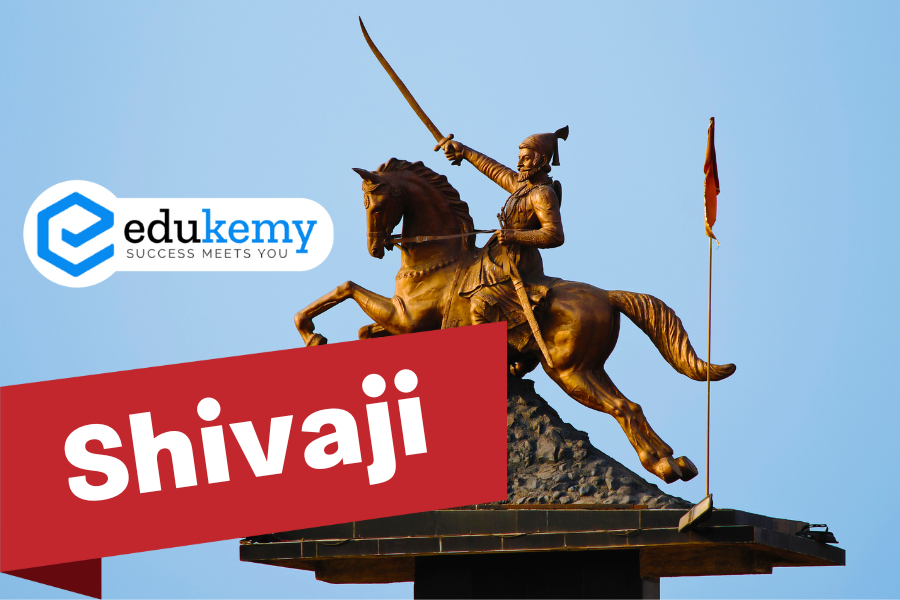
Shivaji was born in the Shivneri fort near Junnar in Pune district in 1627. Shivaji’s mother Jija bai, his teacher Dadaji Kondadev, and his spiritual preceptor Samartha Ramadas played a crucial role in shaping the great personality of Shivaji.
Shivaji expanded his Pune jagir into a powerful kingdom by conquering many territories of Bijapur such as Kondana, Torna (he built the Rayagarh fort here), Javli (the Pratapgarh fort was built here), and Kalyan. In 1659, the Sultan of Bijapur, Ali Adil Shah-II sent his military general Afzal Khan to terminate Shivaji. Sensing the evil thoughts of Afzal Khan, Shivaji assassinated him and later built his tomb according to the Islamic rites at Pratapgarh. Shivaji was secular in his approach and treated all religions with respect.
| Battles fought by Shivaji: 1. The Battle of Pratapgad, 1659 was fought at the fort of Pratapgad near the town of Satara, Maharashtra, between the forces of Shivaji Maharaj and the Adilshahi general Afzal Khan. 2. The Battle of Pavan was fought at a mountain pass in the vicinity of the fort. The sacking of Surat, in 1664 occurred near the city of Surat, Gujarat, between Shivaji Maharaj and Inayat Khan, a Mughal captain. 3. The Battle of Purandar, in 1665 was a major battle fought between the Mughal Empire and Maratha Empire. 4. The Battle of Sinhagad, 1670 occurred on the fort of Sinhagad near the city of Pune, Maharashtra between Tanaji Malusare, a commander of Maratha ruler Shivaji Maharaj, and Udaybhan Rathod, fort keeper under Jai Singh I who was a Mughal Army Chief. 5. The Battle of Kalyan, 1682-83 was significant as Bahadur Khan of the Mughal Empire defeated the Maratha army and took over Kalyan. 6. The Battle of Sangamner, 1679 was again fought between the Mughal Empire and Maratha Empire. This was the last battle fought by Shivaji. |
After conquering several territories from Bijapur, Shivaji diverted his attention towards the Mughal Empire. He attacked and plundered many cities of the Mughal Empire including Ahmadnagar in 1657. Aurangzeb sent an army under Shaista Khan, subedar of Deccan to invade Pune who successfully did it in 1663. Later, Shivaji organized a Guerrilla attack, entered the camp of Shaista Khan, and drove him away. In 1664, Shivaji plundered Surat, the chief port city of the Mughals, and brought a booty of one crore rupees. Infuriated by it, Aurangzeb sent Raja Jaisingh (a Kachwaha Rajput in the service of the Mughals) against Shivaji. Jaisingh defeated Shivaji and concluded the Treaty of Purandhar with him in 1665. According to the treaty:
(i) Shivaji agreed to surrender 23 out of 35 forts to the Mughals.
(ii) Shivaji’s son, Shambhaji had to be appointed in the service of Mughal as a mansabdar of 5000/5000 rank.
(iii) Shivaji had to visit the court of Aurangzeb.
As per the Treaty of Purandar, Shivaji visited the Mughal court in Agra in 1666. Shivaji was humiliated in the Mughal court and was imprisoned in Agra Fort. Later he heroically escaped from the Mughal prison and plundered Surat again in 1670.
In 1674, Shivaji was crowned and assumed the title of Chhatrapati and transferred his capital from Pune to Raigarh. He declared himself as the Kshatriya of the Sisodia clan. Gobrahmana Pratipalaka, Haindava Dharmoddaraka, Hind Padpadshahi, and Dharmaparayana were some of the titles taken by him.
In 1676, he conquered Gingee, Vellore, and Ballari regions with the help of Abul Hasan Tanashah, the Qutubshahi ruler of Golkonda. He died at Raigad in 1680.
Read our ALL MEDIEVAL HISTORY NOTES.
Contents
Frequently Asked Questions (FAQs)
Q: Who was Shivaji?
A: Shivaji Bhonsle, also known as Chhatrapati Shivaji Maharaj, was a Maratha warrior king and the founder of the Maratha Empire in western India in the 17th century. He was born in 1674 and is widely regarded as one of the greatest warriors in Indian history.
Q: What were Shivaji’s major achievements?
A: Shivaji is best known for establishing the Maratha Empire and pioneering the guerrilla warfare tactics known as “Ganimi Kava” to challenge the dominant Mughal Empire. His military strategies, administrative skills, and the establishment of a naval force are among his major achievements.
Q: How did Shivaji contribute to the concept of Swarajya (self-rule)?
A: Shivaji envisioned the concept of Swarajya, emphasizing self-rule and governance free from external control. He established a well-organized and efficient administration that included a council of ministers, a revenue system, and a strong military. His efforts laid the foundation for a self-sufficient and independent Maratha state.
Q: What is the significance of Shivaji’s coronation on June 6, 1674?
A: Shivaji’s coronation at Raigad on June 6, 1674, marked the formal establishment of the Maratha Empire. He took the title of Chhatrapati, which means “paramount sovereign.” The event symbolized the assertion of Maratha power and sovereignty in the face of Mughal dominance.
Q: How is Shivaji remembered in modern times?
A: Shivaji is remembered as a symbol of Maratha pride, military genius, and a charismatic leader who fought for the rights of his people. His legacy continues to influence Indian nationalism, and he is celebrated in various forms, including literature, art, and public monuments. Many cities, institutions, and landmarks in India are named after him to honor his contributions to the nation’s history.
In case you still have your doubts, contact us on 9811333901.
For UPSC Prelims Resources, Click here
For Daily Updates and Study Material:
Join our Telegram Channel – Edukemy for IAS
- 1. Learn through Videos – here
- 2. Be Exam Ready by Practicing Daily MCQs – here
- 3. Daily Newsletter – Get all your Current Affairs Covered – here
- 4. Mains Answer Writing Practice – here

